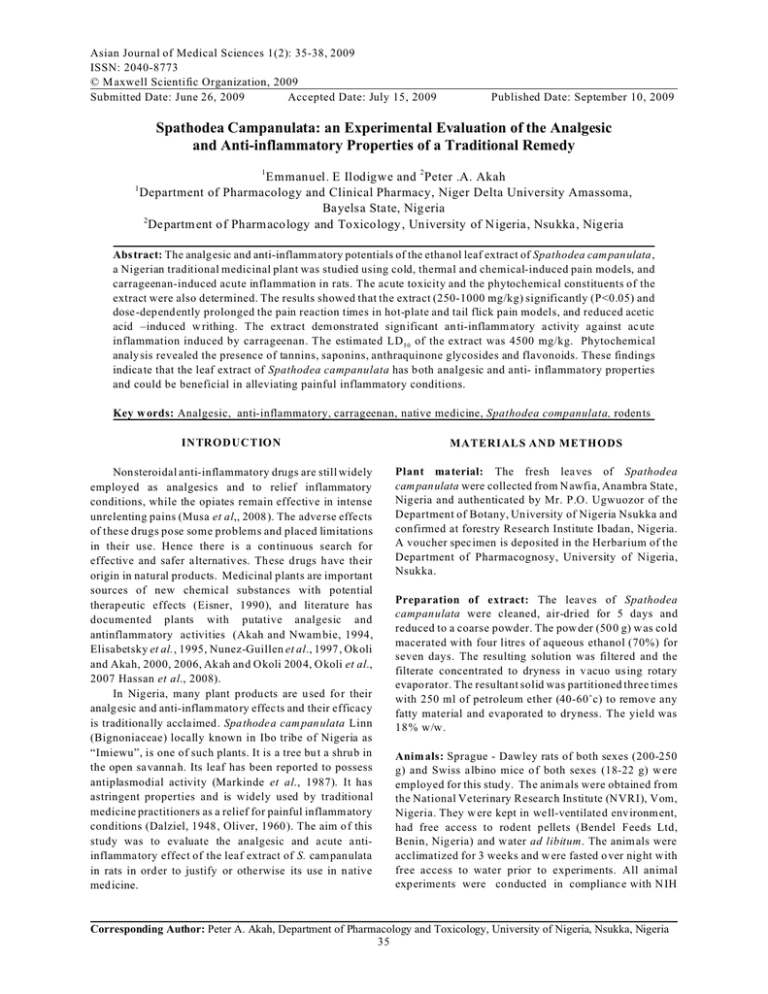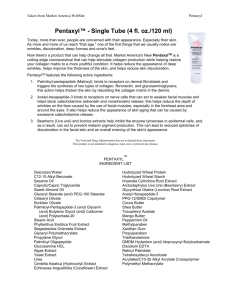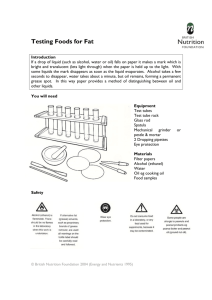Asian Journal of Medical Sciences 1(2): 35-38, 2009 ISSN: 2040-8773
advertisement

Asian Journal of Medical Sciences 1(2): 35-38, 2009 ISSN: 2040-8773 © M axwell Scientific Organization, 2009 Submitted Date: June 26, 2009 Accepted Date: July 15, 2009 Published Date: September 10, 2009 Spathodea Campanulata: an Experimental Evaluation of the Analgesic and Anti-inflammatory Properties of a Traditional Remedy 1 Emmanuel. E Ilodigwe and 2 Peter .A. Akah 1 Department of Pharmacology and Clinical Pharmacy, Niger Delta University Amassoma, Bayelsa State, Nig eria 2 Departm ent of Pharmacology and Toxicology , University of Nigeria, Nsukka, Nigeria Abstract: The analgesic and anti-inflamm atory potentials of the etha nol leaf extract of Spathodea cam panulata, a Nigerian traditional medicinal plant was studied using cold, thermal and chemical-induced pain models, and carrageenan-induced acute inflammation in rats. The acute toxicity and the phytochemical constituents of the extract were also determined. The results showed that the extract (250-1000 mg/kg) significantly (P<0.05) and dose -dependently prolonged the pain reaction times in hot-plate and tail flick pain models, and reduced acetic acid –indu ced w rithing. T he ex tract dem onstrated sign ificant an ti-inflamm atory activity ag ainst acute inflammation induced by carrageenan. The estimated LD 5 0 of the extract was 4500 mg/kg. Phytochemical analy sis revealed the presence of tannins, saponins, anthraquinone glycosides and flavonoids. These findings indicate that the leaf extract of Spathodea campanulata has both analgesic and anti- inflammatory properties and could be beneficial in alleviating painful inflammatory conditions. Key w ords: Analgesic, anti-inflammatory, carrageenan, native medicine, Spathodea companulata, roden ts INTRODUCTION MATERIALS AND METHODS Nonsteroidal anti-inflammatory drugs are still widely employed as analgesics and to relief inflammatory conditions, while the opiates remain effective in intense unrelenting pains (Musa et al,, 2008 ). The adve rse effects of these drugs pose some problems and placed limitations in their use. Hence there is a con tinuous search for effective and safer alternatives. Th ese drugs h ave their origin in natural products. Medicinal plants are important sources of new chemical substances with potential therap eutic effects (Eisner, 1990), and literature has documented plants with putative analgesic and antinflamm atory activities (Akah and Nwam bie, 1994, Elisabetsky et al., 1995, Nunez-Guillen et al., 1997 , Okoli and Akah, 2000, 2006, Akah an d Okoli 2004, Okoli et al., 2007 Hassan et al., 2008). In Nigeria, many plant products are u sed for their analg esic and anti-inflam mato ry effects and their efficacy is traditionally accla imed . Spathode a cam panulata Linn (Bignoniaceae) locally known in Ibo tribe of Nigeria as “Imiewu”, is one of such plants. It is a tree bu t a shrub in the open savannah. Its leaf has been reported to possess antiplasmodial activity (Markinde et al., 1987). It has astringent properties and is widely used by traditional medicine practitioners as a relief for painful inflammatory conditions (Dalziel, 1948 , Oliver, 1960). The aim of this study was to evaluate the analgesic and acute antiinflamma tory effect of the leaf extract of S. cam panulata in rats in ord er to justify or otherwise its use in n ative med icine. Plant ma terial: The fresh leaves of Spathodea cam panulata were collected from N awfia, Anambra State, Nigeria and authenticated by Mr. P.O. Ugwuozor of the Department of Botany, University of Nigeria Nsukka and confirmed at forestry Research Institute Ibadan, Nigeria. A voucher specimen is deposited in the Herbarium of the Department of Pharmacognosy, University of Nigeria, Nsukka. Preparation of extract: The leaves of Spathodea campanulata were cleaned, air-dried for 5 days and reduced to a coarse powder. The pow der (50 0 g) w as cold macerated with four litres of aqueous ethanol (70%) for seven days. The resulting solution was filtered and the filterate concentrated to dryness in v acuo using rotary evaporator. The resultant solid was partitioned three times with 250 ml of petroleum ether (40-60/c) to remove any fatty material and evaporated to dryness. The yield was 18% w/w. Anim als: Sprague - Dawley rats of both sexes (200-250 g) and Swiss albino mice of both sexes (18-22 g) w ere employed for this study. The anim als were obtained from the National Veterinary Research Institute (NVRI), Vom, Nigeria. They w ere kept in well-ventilated env ironm ent, had free access to rodent pellets (Bendel Feeds Ltd, Benin, Nigeria) and w ater ad libitum. The anim als were acclimatized for 3 wee ks and w ere fasted o ver nig ht with free access to water prior to experiments. All animal experiments were conducted in complianc e with N IH Corresponding Author: Peter A. Akah, Department of Pharmacology and Toxicology, University of Nigeria, Nsukka, Nigeria 35 Asian J. Med. Sci., 1(2): 35-38, 2009 Guide for Care an d Use of Laboratory Animals (pub. No. 85-23 rev ised 1985 ). Anti-inflammatory response: The carrageenan-induced acute inflammatory mod el was em ployed (W inter et al, 1962). Thirty rats were fasted for 6 ho urs and divid ed into 6 groups of 5 rats per group. The extract (250,500,750 and 1000 mg/kg, p. o) was administered to groups 1 -4 respectively. The 5 th and 6 th groups received oral administration of acetylsalicylic acid (100 mg/kg, ) and normal saline (10 ml/kg, ) respectively. Thirty minutes later, 0.1ml of freshly prepared 1% carrageena n in sterile saline was injected into the sub-planter surface of each rat hind paw (Winter et al, 1962). The measurement of the linear circumference of each paw before and at 0.50, 1.0, 2.0, 3.0 and 4.0 hours after induction of inflammation was carried out with the aid of cotton thread. The mean paw circumference and p ercen tage inhibition of oedema was determined (Okpo et al., 2001 and Oriow o, 1982). Phytochemical test: The ph ytochem ical analysis of S. cam panulata extract was carried out using standard protocols (O debiyi and Sofow ora 1978 ). Acu te toxicity study: Sixty m ice w ere divided into six groups of ten per group after six hour fasting period. The mice in grou p 1 received norm al saline (10 m l/kg oral) while the mice in groups 2-5 received oral doses of the extract (500, 1000, 200 0, 400 0, 500 0, mg /kg respectively). The animals were observed for obvious toxic symptoms and mortality in each group within 24 hr was recorded. The median lethal dose of the extract (LD 5 0 ) was estimated using probit analysis (Miller and Tainter, 1944 ). Statistical analysis: The results are represented as means ± SEM and significanc e of differences between control group and extract treated groups were determined using Student’s t-test and two way ana lysis of variance (AN OV A). P value < 0.05 was considered significant. Effect on acetic acid-induced writhing:The method described by Koster et al, (1959) and Taber et al, (1969) was used. Thirty mice were fasted for 6 hours and divided into six groups o f five animals per gro up. Groups 1-4 received the extract orally (250 , 500, 750 and 1000 mg/kg, respectively). The 5th group received distilled water (10 m l/kg, oral) wh ile the 6th group was given aspirin (100 mg/kg, ora l) 30 minutes before administration of 1% acetic acid solution (0.1 ml/kg, i.p). The writhes (each of which is characterized by a wave of contraction of abdominal musculature followed by extension of the hind limbs) were counted 5 minutes after acetic acid injection for a period of 3 0 min utes. A reduction in the numb er of w rithes ind icates analgesic property. RESULTS Phytochemical results revealed the presence of tannins, saponins, anthraq uinon e glycosides, and flavonoids, while the oral LD 5 0 of the extract was estimated to be 4500 mg/kg Effect on acetic acid-induced writhing: The extract evoked significant (p<0.05) and dose-dependent reduction in the number of acetic acid-induced writhes in rats. At 1000 mg/kg the effect of the extract was comparable to that of 100 m g/kg of aspirin (Table 1). Effect on tail flick response: This study was based on the method described by Clark et al, (1988 ). Thirty rats were fasted for 6 hours and divided into six groups of five animals per group. Groups 1 -4 received the extract orally (250,500,750 and 1000 mg/kg respectively). Group 5 received distilled water (10 ml/kg) while the 6 th group received morphine (10 mg/kg, oral). Each rat was closely restrained in a wire mesh cage and the low er half of its tail dipped in a beaker of cold water (0-1/C). The time in seconds for tail withdrawal from the water was taken as the reaction time. The reaction time was determined before and at 30 minutes interval after adm inistration of the extract, distilled water or morphine. Effect on tail flick response: The extract produced a dose-dependent increase in the reaction time to tail flick. The percentage inhibition by the extract at 1000 mg/kg was com parab le to that produced by morphine 10 mg/kg (Table 2). Effect on hot plate analgesia: A significant (p<0.05) and dose-dependent elevation of the after treatment reaction time to therm al pain was evident in the extract treated animals. The effect of the extract (1000 mg/kg) was com parab le to that produced by 10mg/kg of morphine (Table 3). Effect on hot p late analgesia: Thirty rats were fasted for 6 hours and divided into six groups of five animals per group. Groups 1-4 received the extract orally (250,500,750 and 1000 mg/kg respectively). Group 5 received distilled water (10 ml/kg) while the 6th group received morphine (10 mg/kg p.o). Each mouse was gently placed on the hot plate m aintained at 55 ± 0.5/C and the time required by the mouse to lick the paw or jump were taken as the respon se (Turner, 1965). The cutoff time or laten cy response w as 15 seconds to avoid tissue damage. Carrageenan-induced oedem a: The effect of the extract on carrageenan-induced oedema is shown in Tab le 4. The extract produced a dose-dependent inhibition of oedema induced by carrageenan. The percentage inhibition produced by the extract (1000 mg/kg) was com parab le to that produced by of acetylsalicylic acid at the 3rd hour post-carrageenan injection. 36 Asian J. Med. Sci., 1(2): 35-38, 2009 Tab le 1: Effect of the extract on acetic acid-induced writhing in mice Treatment Dose(mg/kg p.o) No of w rithes Percentage per 30 min inhibition Control 10ml/kg 81.6±3.72 Extract 250 70.2±2.04* 13.97 500 62.0 +5.10* 24.02 750 54.4±1.30* 33.30 1000 48.0±0.63* 41.18 Asp irin 100 52.4±5.24* 35.78 *P< 0.05 c om pared with th e con trol. Table 2: Effect of the extract on tail flick in rats Treatment Dose Pre-treatment Post- treatment (mg/kg p.o) (sec) (sec) Control 10ml/kg 15.4±1.02 15.6±1.86 Extract 250 16.8 ±1 .6 25.2±2.54* 500 17.0±1.41 34.0±2.83* 750 15.7 ±1 .3 37.2±1.90* 1000 15.4±0.80 54.6±2.65* Morphine 10 15.4±1.02 44.8±2.64* P<0 .05 co mp ared w ith the co ntrol. Table 3: Treatment Effec ts of the e xtract on hot pla te Dose Pre-treatment (mg/kg p.o) (sec) Control 10ml/kg 2.2±0.40 Extract 250 2.6±0.80 500 2.8±0.90 750 2.8± 1.0 1000 3.0±0.87 Morphine 10 2.5±0.40 *P < 0.05 c om pared with th e con trol. test Post- treatment (sec) 2.2±0.45 4.2±0.40* 5.4±0.98* 5.4±0.98* 9.4±049* 10.0±0.86* on carrageenan-induced paw oedema. Carrageenanoedema is a model of acute inflammation used in the study of non-steroidal anti-inflam matory age nts (Di Rosa et al., 1971). The effects of the extract was most pronounced, 3 hours after induction of oedema, an action which was similar to that of acetylsalicylic acid, suggesting its usefulness in the manag eme nt of acute inflammation. Phytochemcial analysis revealed the presence of tannins, saponins and anthraquinone glycosides and flavonoids. The pharmacological activities of medicinal plants are usually due to their secondary metabolites. Some of the constituents of the extract have been documented to possess analgesic and anti-inflamm atory activities (Park et al, 2001, Okoli and Akah 2004). The high LD 5 0 value of the extract is an ind ication of its safety (Lorke 1983). In conclusion, the results of this study provide evidence for the analge sic and anti- inflam matory activity of the ethanol leaf extract of Spathodea campanulata thus supporting the validity of its use in painful inflamm atory conditions. Bioassay guided fractionation and isolation of the active compound is in progress. % Inhibition 1.20 33.33 50.00 57.79 62.98 63.63* % Inhibition 38.09 55.56 61.11 68.09 75.00 Tab le 4: Ef fect of th e extrac t on ca rragee nan in duce d oed ema in rats Treatment Dosage (mg/kgp.o) P a w si ze (m m ) -----------------------------------------------------------------------------------------------------------------------------------0h 0.5h 1h 2h 3h 4h Control 10 ml/kg 27.2 ± 0 .3 27.4 ± 0 .5 29.8 ± 0.84 30.6 ± 0.48 32.2 ± 0.40 30.4 ± 01.35 Extract 250 26.9 ± 0 .6 25.2 ± 0 .4 25.6 ± 0.49* 26.6 ± 0.49* 27.4 ± 0.50* 27.8 ± 0.84 (8.30) (14.09) (13.73) (14.91) (8.55) 500 27.0 ± 0 .3 23.2 ± 0.40* 24.2 ± 0.80* 25.2 ± 0.30* 25.6 ± 0.45* 25.8 ± 0.40* (15.33) (18.79) (17.65) (20.50) (15.13) 1000 27.1 ± 0 .5 21.4 ± 0.48* 22.2 ± 0.40* 22.6 ± 0.42* 22.4 ± 0.8* 23.2 ± 0.40* (21.90) (25.50) (28.14) (30.40) (23.68) Ac etylsalicylic ac id 100 26.9 ± 0 .7 19.6 ± 0.5* 20.3 ± 0.30* 20.8 ± 0.42* 20.9 ± 0.55* 21.2 ± 0.61* (28.47) (31.88) (32.03) (35.09) (30.26) *P<0.05 com pared with the control. Percentage inhibition is shown in parentheses. DISCUSSION REFERENCES The results of this study revealed that the ethanol leaf extract of S. cap anulata possess both peripheral and central analgesic properties. Acetic acid-induced nociception is usually use d for the evaluation of mild peripheral analgesic and no nsteroidal anti-inflamm atory compounds (Ferrerira and Vane, 1974; Berkenkoff and W eichman, 1998; Hassan et al, 2008). On the other hand thermal painful stimuli are selective for the evaluation of centrally, but no t peripherally acting analge sic drugs (Chau, 1989). These results suggest that the extract may possess NSAID- like and opiod-like analgesic activities, mediated through both the peripheral and central mechanisms. However, the results of the flick tail and thermal (hot plate) experiments appear to suggest that the extract is more effective in allev iating central pain than periph eral (acetic acid ) pain The carrageenan-induced inflammatory reactions have been shown to be due to the release of inflamm atory mediators (Heller et al, 1998; Nunez-Guillen et al, 1997; Ndebia et al., 2007). The e xtract of S. cam panulata produced dose-dependent acute anti-inflammatory effects. Akah, P.A, and A.I. Nwam bie, 1994. Evaluation of Nigerian Traditional M edicine: 1.Plants used for Rheum atic disorders. J. Ethnop harm acol., 42:179-182 Akah, P.A. and C .O. O koli, 2004. M echa nism of the anti-inflammatory activity of the leaf extract of Culcasia scandens, P. Baeuv., (Araceae). Pharm. Biochem. Bev., 79: 473- 481. Berkenkoff, J.W . and B.M. W eichmann, 1988. Production of Prostacyclin in mice following i n t ra p e r i ti o n e a l i n j ec t i o n o f a c etic acid , phenylbenzoquinone and zym osan: its role in the writhing response. Prostaglandins, 36: 693-709. Chau, T., 1989. Pharmacological Methods in the Control of Inflammation. In: Modern Methods in Pharmacology. R. Alan, (Ed.), Liss Inc. New Yrok, 5: 195-212. Clark, S.J., R.L. Follenfant, and T.W. Smith, 1988. Evaluation of opio d-induced antinociceptive effects in anaesthesized and conscious animals. Br. J. Pharmacol., 95: 275-282. 37 Asian J. Med. Sci., 1(2): 35-38, 2009 Dalziel, J.M., 1948. The useful plants of West Tropical Africa. The Crown Agents for Overseas Co lonies. London, pp: 397-399. DiRosa, M., J.P. Giroud and D.A. Willoughby, 1971. Studies of the mediators of the acute inflamm atory response induced in rats in different sites by carrag eena n and turpen tine. J. Pathol., 104: 15-2 9. Eisner, T., 1990. Chemical prospecting. A call for Action. In: Ecology, Econom ics and Ethics. The Broken Circle. F.H. Borm an an d S.R . Keller, (Eds.). Y ale University Press New Haven, CT. Elisabetsky, E., F.A. Amador, R.R. Abuquerque., D.S. Nunes, and A.C.T. Carv allo, 1995. A nalge sic Activity of Psychotria cola rata. J. Ethnophama col., 48: 77-85. Ferreira, S.H. and J.R. Vane, 1974. New aspects in the mode of action of non-steroidal anti-inflammatory drugs. Ann. Rev. Pharmacol., 14: 57-73. Hassan, H.S., A.A. Ahmadu, and A.S. Hassan, 2008. Analgesic and anti-inflammatory activities of Asparagus africanus root extract. Afri. J. Trad. CAM ., 5(1): 27-31. Heller, A., T. Kock., J. Schemck and V.K. Acker, 1998. Lipid mediators in inflammatory disorders. Drugs, 55: 487-496. Koster, R., M. Anderson, and E.J. Debeer, 1959. Acetic acid analgesic screenin g. Fed . Proce d., 18: 418-420. Lorke, D., 19 83. A new appro ach to practical acute toxicity testing. Arch. Toxicol., 53: 275-289. Markinde, J.M., E.K. Adesogen and O.O.G. Amusan, 1987. The Schizon tocidal activity of Spathoda cam panulata leaf extract on Plasmodium berghei berghei in mice. Phytother. Res., 1(2): 65-68. Miller, L.C. and M.C. Tainter, 1944. Estimation of LD 5 0 and its error by means of logarithmic-probit graph paper. Proc. Soc. Exp. Biol. Med., 57: 261-264. Musa, Y.M ., A.K . Haruna, M. Llyas, A.H. Yaro, A.A. Ahmadu and H. Usm an, 20 08. Ph ytoch emical, analg esic and Anti-inflammatory effects of the ethylacetate extract of the leaves of Pseudocedrall kotschyll. Afr. J. Trad. CAM., 5(1): 92-96. Ndebia, E.J., R. Kamgang, and B.N. Nkeh-chungag A.nye, 2007. A nalgesic and anti-inflamma tory properties of aqueous extract from leaves of Solanum torvum. (solanaceae). Afr. J. T rad. C AM ., 4(2): 240-244. Nunez-Guillen, M.E., J.A. Silva-Emimi, C. Souccar and A.J. Limdala, 1997. Analgesic and anti inflammatory activities of the aqueous extract of Plantugo major (L). Int. J. Pharmacogn. 6: 465-472. Odebiyi O.O. and E.A. Sofowora, 1978. Phytochemical screening of Nigerian medicinal plants. Lloydia, 41: 234-235. Okoli, C.O. and P .A. Akah, 2000. A pilot evaluation of the anti-inflammatory activity of Culcasia scandens, a traditiona l antirheu matic agen t. J. Altern. Co mpl. Med., 6: 632-637. Okoli, C.O. and P.A. Akah,.2006. Analgesic activity of leaf extract of Culcasia scandens P. Beauv, Ind. J. Exp . Bio., 44: 422 -424. Okoli, C., P.A. Akah., S.V. Nwafor, U.U. Ihemelandu and C. Amadife, 2007. Antiinflamm atory activity of seed extracts of Aframomum melegueta. J. Herbs Spice s M ed. Plants, 13: 11-21 . Okpo, S.O., F. Fatokun, and O.O. Adeyemi, 2001. Analgesic and anti-inflamm atory activity of Crinum glaucum aqueous extract. J. E thnopharmacol., 78: 207-211. Oliver, 1960 . Medicinal plants in Nigeria. Nigerian College of Arts, Science and Technology, Ibadan, Nigeria, pp: 23. Oriowo, M.A, 1982. Antiinflammatory activity of piperonyl-4- acrylic isobutyl amide an extractive from Zanthoxylum zanthoxyloids. Planta. Medica., 44: 54-56 Park, E.H., J.H. Kahng, S.H. Lee, and K.H. Shin, 2001. Anti-inflammatory princip les from cactus. Fitoterapia, 72: 288-2 90. Taber, R.I., D.D. Greenhouse, J.K. Rendel and S. Irwin, 1969. Ago nist and antagonist interactions of opiods on acetic acid induced abdominal stretching in mice. J. Pharmacol. Exp. Therap., 169: 29-37. Turner, R.A. 1965. Screening Methods in pharmacology. Academic Press; New Y ork, pp: 158. W inter C.A ., E.A. Risley and G.W. Nuss, 1962. Carragee nin induc ed oe dem a in hind paw of the rat as an assay for anti-inflammatory drugs. Proc. Soc. Exp. Biol., 111: 533-547. 38





